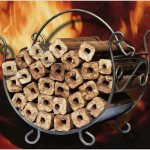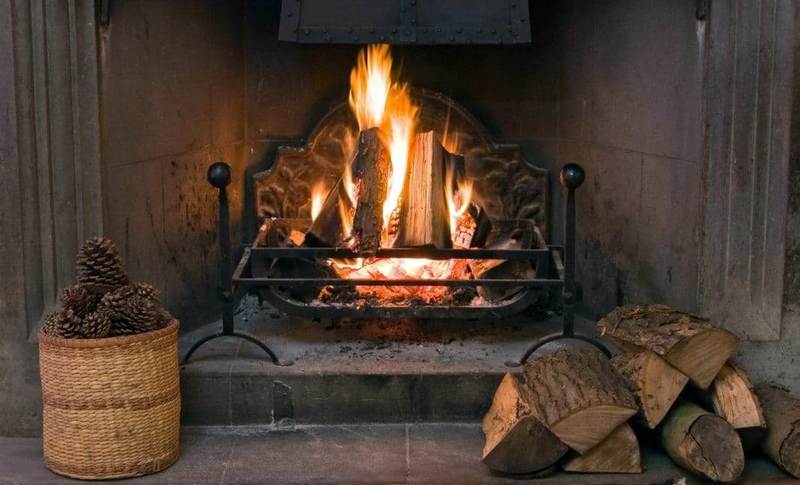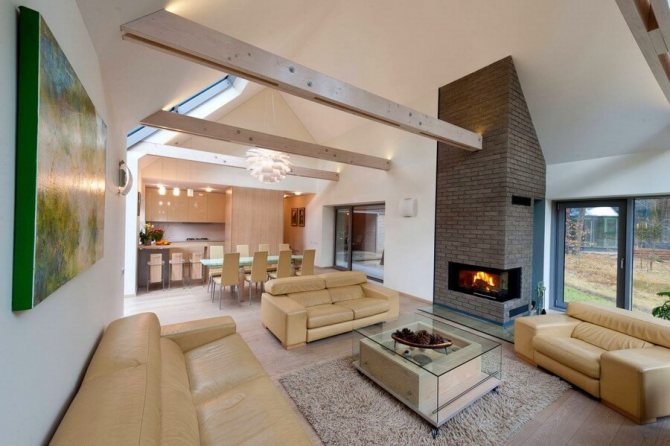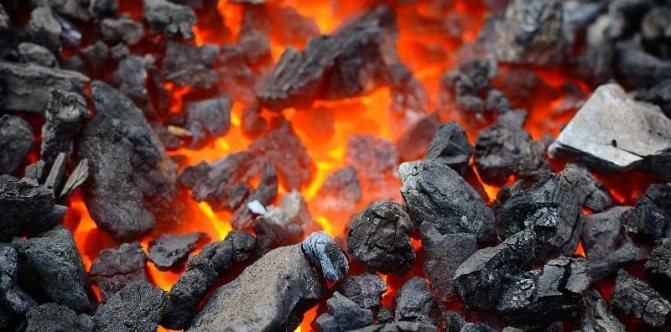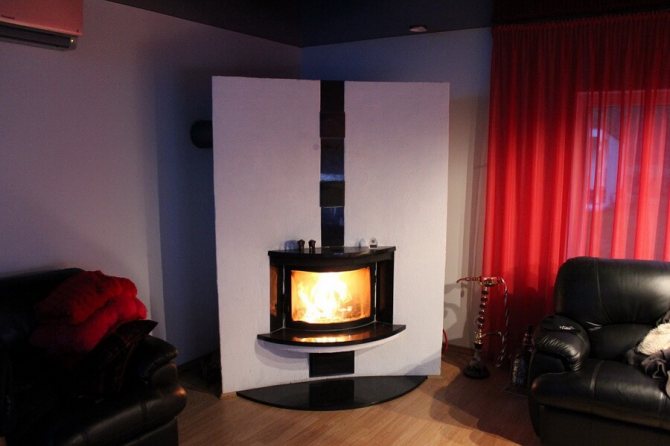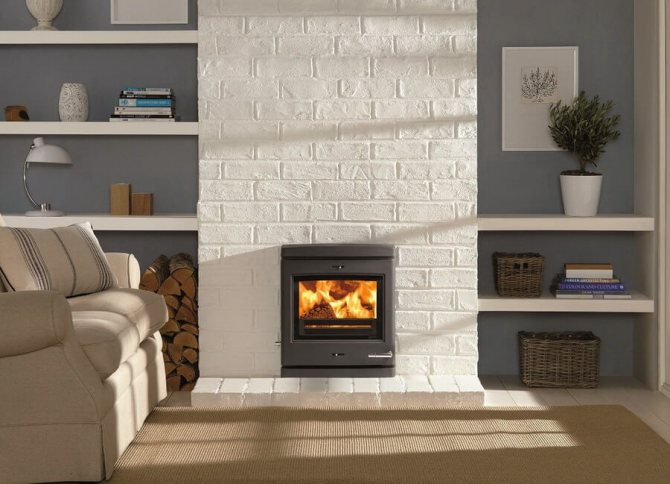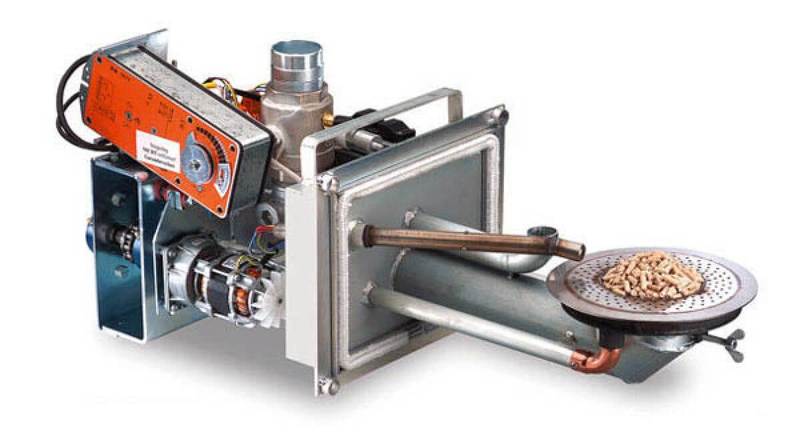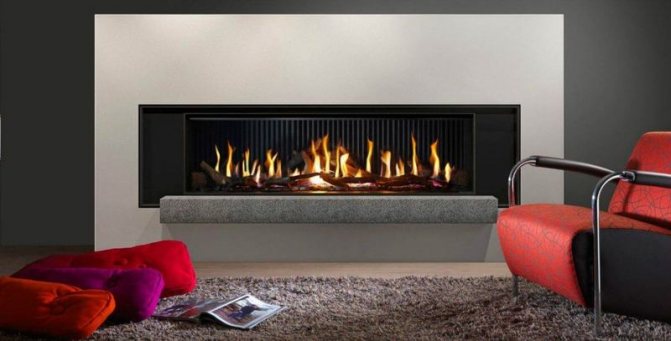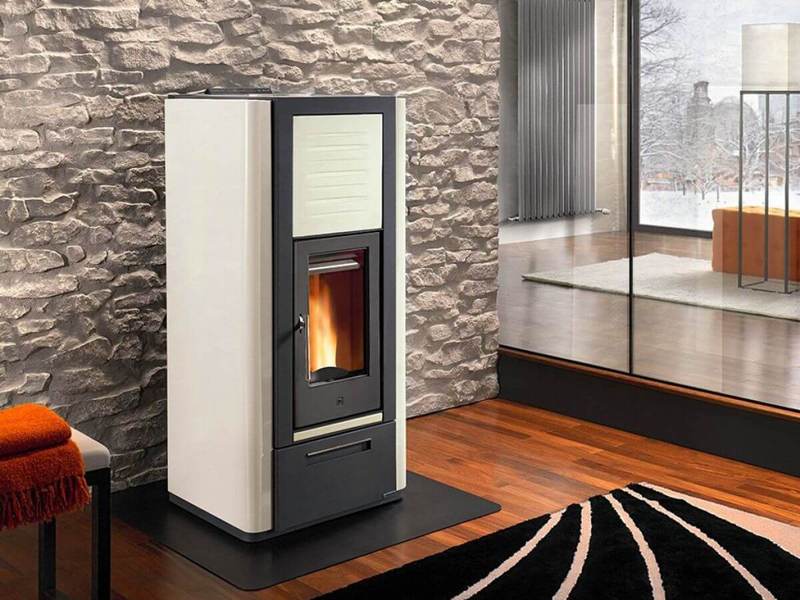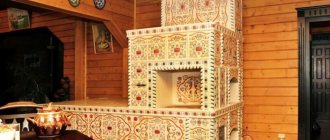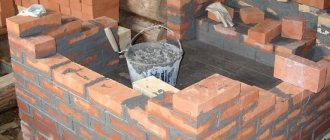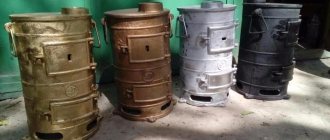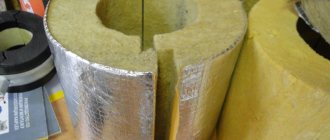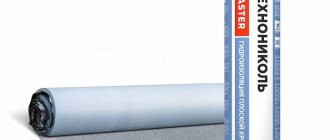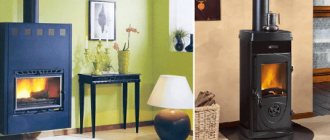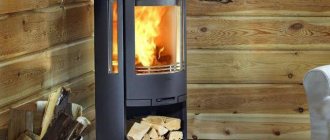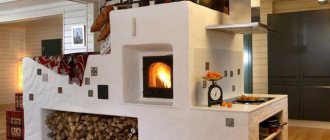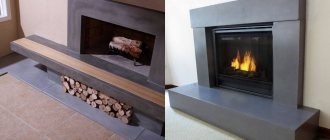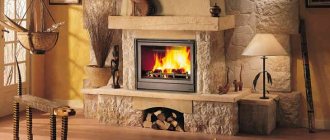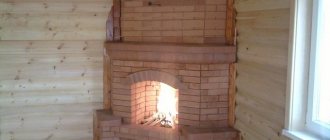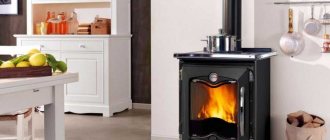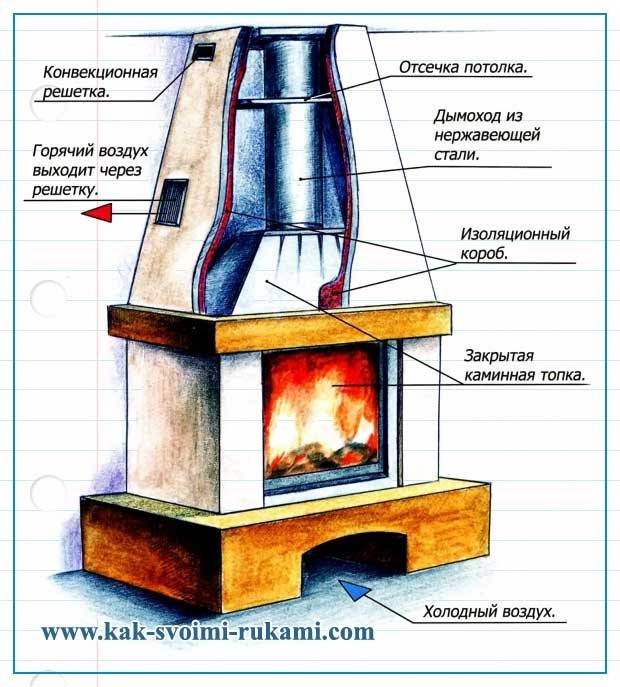
With the onset of cold weather, a cozy fire in a wood-burning fireplace will warm the house and cheer up.
But why is one fireplace more useful and less useful from another? Of course, heat transfer depends on the type of fireplace, the size of the firebox and the material from which it is made. However, you should not look for the reason in a bad choice - perhaps proper home care will solve the problem.
Reference by topic: How and what to make a fireplace with your own hands
EVERYTHING YOU NEED FOR THIS ARTICLE IS HERE >>>
Fireplace combustion chamber with Euro wood
Choosing which wood is better drown fireplace, give your own preference to briquettes. Eurodrova is a fuel designed specifically for air heating. It has a lot of good qualities in comparison with ordinary logs:
- The flame during the use of briquettes flares up faster than in the combustion chamber with wood.
- Eurowood is made of pressed wood, the moisture content of the material will not be more than 11%. Thanks to this, the flame comes out the same and does not spark.
- One full load of briquettes will burn for 2 hours.
- In the process of burning Euro wood, the heat transfer is 30-50% higher than after using ordinary wood.
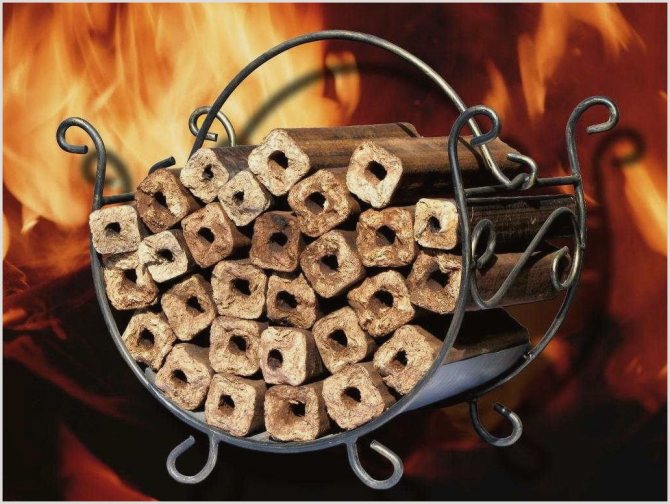

Eurowood is made of pressed wood or peat
Eurowood can be made of wood or peat. Peat coals take a long time to ignite, but the flame will also last twice as long in comparison with a wooden similarity.
How it works
The power of the stove can be adjusted very simply if there is a tightly closing door (Feringer, Supra, Torma, Keddi, and other manufacturers) and a smoothly and tightly closing combustion air supply regulator. Heat storage is similar to that of ordinary stone. We can talk about stoves-fireplaces like this: they perform the function of a stove - they give off heat for a long time, but not due to its accumulation, but due to the slow combustion of firewood. The upper firewood ignition system means the initial ignition of a cold stove (fireplace), and not the subsequent laying of firewood. For example, the Milan II stove can simply be fired up from above if you follow the instructions (on the Feringer plant website). The design of this stove also has an air supply from above, which greatly facilitates ignition. But in the Milano stove, kindling with the top loading takes place a little in this way - the manufacturer does not recommend filling the full firebox right away, but at the bottom there is a door through which I set fire to it and forgot. Then you can add firewood, as needed, and adjust the air supply.
The Milan stove can and must be fully loaded and ignited from above. And there is no need to fuss, kindle a little, with the help of the upper ignition everything will start in ideal mode - there will be no smoke, the draft will quickly become normal, the heating of the stove will go smoothly. There should be enough firewood in the firebox so that the room immediately warms up well.
If you fire up this stove as usual, then of course, you need to put in a little firewood, otherwise you will get uneven heating, or overheating, which is even dangerous. In this regard, it is also worth recalling that in no case should you kindle a fire with brushwood, build "huts" inside the firebox and similar structures, which concentrate air, supposedly contributing to combustion - the stove will quickly fail if you do this. With the upper ignition, the entire mass of the logs cannot flare up at once, therefore there will be no local overheating. Rapid heating of the chimney removes condensate, and this significantly increases the service life of the chimney.
The upper ignition gives uniformity of combustion and almost twice in time for the same bookmark, under the same conditions. For this, it is desirable to organize the supply of secondary air. In the photo with the firewood, you can see how, when the oven is full, the stove is ignited on the top right. After 30 minutes, it can be seen that the lower layer of firewood is just starting to flare up. For the analysis of combustion with different ignition, I propose readings of the gas analyzer for the upper and lower ignition in the same furnace with 10.5 kg bookmarks (with a full firebox, three or four rows of fuel from below before ignition).
Below is the analysis data for the upper ignition.
Use of firewood as fuel
Nothing beats a real wood fire. Distinctive crackling and lively flames are only possible if real logs are used.
There are several invisible moments like drown
fireplace with wood correctly:
- It is necessary to comply with the rules for storing firewood. The room can be heated exclusively with dry wood, which contains as little moisture as possible. Firewood from trees that have just been felled will not work. It is necessary to use logs that have dried for at least a year. Such wood is easy to distinguish - it has a much darker shade in comparison with other wood, there are several cracks on its surface. The burning process of dry wood is characterized by a clearly distinguishable crackling sound.
- The logs must be the same size. The thickness of the tree should be no more than 6-10 cm, otherwise the log will burn out badly. The length should be? parts of the furnace hole.
- For camera combustion fireplace
a horizontal way of laying firewood is used. Logs are placed in the furnace hole next to each other with an interval of 1 cm.The height of the bookmark should not be more than the 30 cm mark.
Another important sign of how to heat the stove is the choice of wood species for kindling the fireplace.
What wood is suitable for a fireplace combustion chamber?
How warm will the room be after combustion chambers
fireplace, how much soot and smoke there will be - it all depends on the type of wood for kindling. You need to know for sure which wood is better
drownfireplace... The following wood species are used for kindling:
- Hardwood. These include birch, hawthorn, pear and apple. It is a malleable wood that ignites easily. During combustion, some tar and soot are released.
- Hard rocks. For long-term burning, it is better to choose logs of oak, yew and beech. Such firewood is hard to chop, it takes a very long time to ignite. But the logs will also burn longer than other types of wood.
- Softwood. Elm, cherry, cedar and fir emit much less heat than other types of wood. Among other things, the logs smoke heavily, a significant amount of soot and ash is formed. It is necessary to refrain from choosing such embers if the chimney has a rectangular shape and a small hole. If the draft of the air duct is weak, smoke can fill up rooms.
- Conifers. To create a pleasant aroma in the room, pine and spruce logs are used. Coniferous trees burn quickly, but the flame comes out uneven, many sparks are formed. A significant amount of smoke and soot is also emitted. Due to the high resin content in conifers, coals can fall out of the fireplace, which is considered very unsafe.
- Cleansing rocks. These include alder and aspen. The wood does not emit smoke during combustion. From the use of firewood from alder and aspen, not only soot is not emitted, but also soot is cleared from the chimney. It is best to heat fireplace if used frequently with cleansing sticks, at least once every 14 days.
- Fragrant branches. Fragrant tree branches can be added to the fireplace flame, which will fill the room with a good smell. You can use the branches of fruit trees. The addition of juniper branches to the fire will bring healing and relaxing effects.
Video review. Smart fireplace from Palazzetti - iPhone instead of a lighter!
Publication date: 08 February 2016
presents to your attention an interesting video from its partner - PechObzor channel. This time, the video material presents an advanced, even we can say with confidence - a revolutionary option for fireplace equipment. We are talking about the function of automatic and remote firewood ignition in the fireplace using an ordinary smartphone or tablet. The new video shows in detail the work of the system for kindling the fireplace at a distance from the famous Italian manufacturer Palazzetti. The process is clearly demonstrated by the director of one of the very first salons - Denis Repin.
Motherboard, turbine, burner, tablet - and there is no more cold in the house by your arrival!
This new and amazing technology is shown in detail on the example of a working hearth and ECOMONOBLOCCO firebox from Palazzetti. As it becomes known, automatic ignition is carried out using an ordinary telephone and a motherboard installed along with the firebox. The motherboard is connected to a special auto-ignition kit with a turbine and a burner made of cast iron, on which a small amount of pellets is poured. Also, a launch modem is connected to the system - an ordinary SIM card is inserted into it, where the phone number from which the ignition commands will be received is pre-recorded. Further, firewood is put on the fireplace bull for future kindling - first small, then large - so that they flare up better. Now you can safely go about your business, being confident that upon your return the house will be filled with comfortable warmth.
Just one command for automatic ignition from a distance!
On the way home, the user, using the application, sends a regular SMS message with a special command to the launch modem. The GPS antenna receives the remote signal and sends a start command to the control unit. Immediately after this, a special electrical element begins to heat up, on which the pellets prepared in advance lie. They quickly flare up, the flame spreads to the wood and, while you are driving home, the heating process begins. The ignition process takes place behind a closed firebox door and takes from 1 to 3 minutes. The video also demonstrates additional control panels with which you can control combustion settings, flame intensity, control temperature, adjust the speed of the turbine and other processes.
Remote fireplace ignition - exclusive for Russia
In conclusion of the video review, the director of the Domotechnika salon notes that the innovative system of automatic ignition of the fireplace at a distance is currently available only for Palazzetti products. Thanks to the exclusive partnership of our company with the manufacturer Palazzetti, a remote fireplace ignition system can be purchased in Russia - in any of the salons throughout the country.
Pay attention to the products that are described above
Cladding Monaco, under the MBL round 66 (Palazzetti)
Palazzetti (Italy) Article number: 801319020
Corner fireplace in Soleado marble. Fireclay brick worktop. Mantel walnut-look.
RUB 271,745
in stock <5
| ST. PETERSBURG | 1 PC. |
| MOSCOW | under the order |
| NOVOSIBIRSK | under the order |
| YEKATERINBURG | under the order |
Fireplace Ecomonoblocco 66 V08 tondo (Palazzetti)
Palazzetti (Italy) Article: 802572790 *
The firebox is made of very thick cast iron. Rounded glass. Quiet door lift mechanism. Power: 20.22 kW
RUB 458 660
in stock> 5
| ST. PETERSBURG | > 5 pcs. |
| MOSCOW | 1 PC. |
| NOVOSIBIRSK | under the order |
| YEKATERINBURG | 1 PC. |
Coal for fireplace combustion chamber
Coal fuel is rarely used for fireplaces. You need to know clearly how to do it right drown charcoal fireplace to make the stove last longer.
Stoke the fireplace
coal is possible only if there is a grate in the furnace. In the process of burning coal, a significant amount of ash is formed, which must be removed in time. Also, there should be a specialized cover near the fireplace that will close the furnace hole. The blower door must be kept open until the flame has ignited.
For camera combustion fireplace
both brown and stone are suitable
coal... It is necessary to select the variety, the combustion temperature of which is within 1500 degrees.
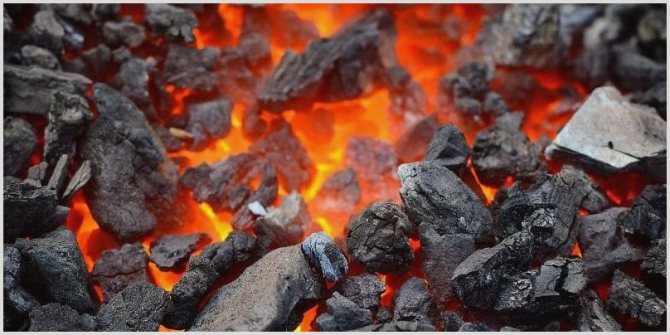

Coal only suitable for those fireplaces with a grate
Melt fireplace before setting coal, it is best to use small firewood. When they light up perfectly, lay down a layer of very small charcoal. It must be no thicker than 5 cm.After that, you can add a more massive coal
... In the furnace hole, the height of the bookmark should not be higher than 15 cm.
Coal dust can also be used to light a fireplace. To do this, you need to roll the dust into paper or newspaper and moisten it a little. The bundles can be placed in the corners of the fuel port.
What kind of stoves can be fired with coal
The burning temperature of coal is higher than that of logs, so the coal stove must have a special design. By and large, a simple brick stove is also suitable, but its firebox should have walls of increased thickness, and the grate should be placed in two rows below. In addition, such a design should provide for a separate hood for coal that does not interact with other systems.
In some cases, two boilers with water are placed in the furnace, designed to heat the room and prevent the brick walls from overheating. In such ovens, care must be taken to ensure that the pipes do not run out of water.
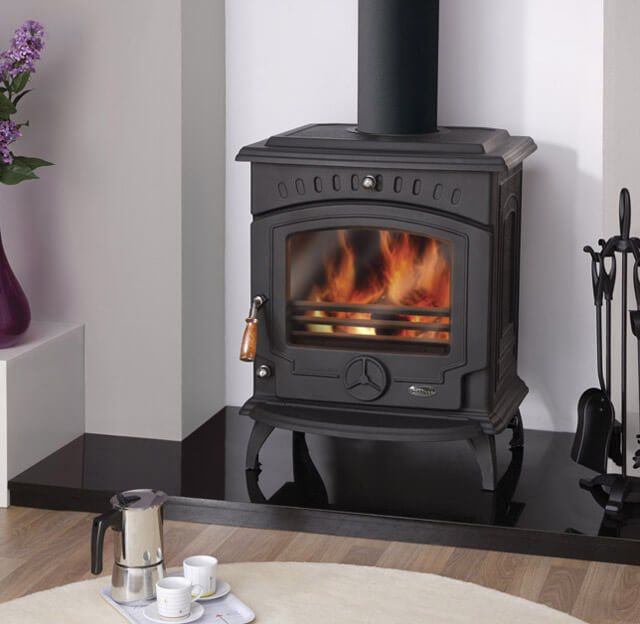

To avoid heat loss, the grate and ash pan must be suitable in size. To increase the efficiency of traction, special nozzles are installed on the furnace.
Smoke can occur for the following reasons:
- stove channels or smoke stack are clogged;
- cracks in the oven masonry;
- the internal oven masonry began to collapse;
- connecting a stove to the chimney of another stove without a special divider.
Gas fuel for fireplaces
Some types of fireplaces are powered by a gas burner. In order to maintain the combustion process in a gas fireplace for 85 hours, one cylinder of liquefied gas is needed. The heat transfer during the combustion of gas is 2.5 times higher than during the use of solid fuel.
The most important thing to worry about when using gas fuel is the safety of storage and operation of gas cylinders. You need to worry about the following points:
- Gas cylinders should be placed in an individually isolated room with a supply-type ventilation system. This storage arrangement is necessary to prevent results from a suspected gas leak.
- The power of the fireplace determines which type of ventilation should be used in the fireplace. A combined ventilation system is suitable for a small fireplace. A high power oven must be equipped with a high draft chimney.
- In the room where the fireplace is located, there must be specialized sensors that warn of a very high level of gas in the air.
Two types of substances are used as fuel - propane-butane and network gas.
Biological fuel for fireplaces
Certain types of fireplaces run on environmentally friendly raw materials - biofuel. This liquid combustible material is made by converting biological raw materials into pure alcohol. During combustion, biofuel decomposes into carbon monoxide and superheated steam. Heat is generated during this process. The heat output from biofuels is significantly greater than the heat from a wood-fired fireplace.
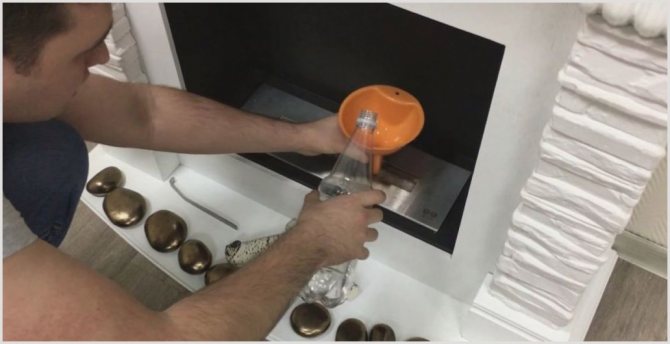

Biofuel is an alcohol-based liquid fuel
Biofuels have many good qualities. In the process of burning, even tongues of flame are obtained, soot and soot are not released. There is no smoke coming from the flame, and there is still no smell. To add the sound of the firewood crackling to the fire, a sea salt biofuel is released to perform a believable imitation.
Ignition with natural compounds
This category primarily includes compositions based on birch tar. The product is used in the same way as other means for ignition - they pour over the coals, wait three minutes, and carefully set them on fire. Tar has a specific odor and forms a pungent smoke. After a few minutes, heavy substances burn out, the smoke becomes transparent, the specific smell disappears. Still, for the first 10-15 minutes you will have to breathe resinous volatile vapors with a characteristic aroma.
In the event that the fuel material is not dry enough, lighter fluid with tar will not help. Other products based on natural oils or resins are not effective for igniting damp material.
Not all products are suitable for quick cooking of meat, when it is necessary to maintain a stable high temperature for 15 minutes. The wind can extinguish the fire in the barbecue, so the equipment is always placed behind a special fence. The best option is to prepare food in a barbecue gazebo or on a semi-covered veranda.
Safety rules for a fireplace combustion chamber
Fireplace is considered an interesting decorative element for every room. But you need to remember that everything where there is fire should be as harmless as possible. With the camera combustion fireplace
it is necessary to adhere to several mandatory rules:
- It is necessary to constantly inspect the combustion hole and chimney, assessing their integrity and the degree of contamination. If the fireplace is used more often, a lot of soot and soot forms on the walls of the air channel. Due to this, the draft of the chimney is weakened, and the smoke begins to partially make its way into the room. With a high concentration of carbon dioxide in the room, there is a danger of poisoning or getting eels.
- The ignition must be carried out in stages. First of all, use flammable materials such as small logs, sawdust and old newspapers. And only after they are very burned, add fuel for more heat.
- During the operation of the fireplace, the damper regulating the draft in the fireplace must be slightly open.
- Do not throw rubbish, painted logs or add flammable liquids into the fireplace. The smoke from such substances is toxic, which provokes poisoning.
It seems if in fireplace put more fuel, the flame will burn brighter and there will be more heat. But this is not at all correct. All the heat will go into the pipe. The fuel will burn in the same way as with a smaller setting. It is also necessary not to forget that if you fill the combustion chamber to the top with solid fuel, the walls of the fireplace can be damaged, which will reduce the operating period of the stove as much as possible, and at worst, lead to a fire. Because of this, it is best to use the fireplace fuel very carefully, following specific rules.
A few words of professionals about logs or why you need to prepare for kindling ahead of time
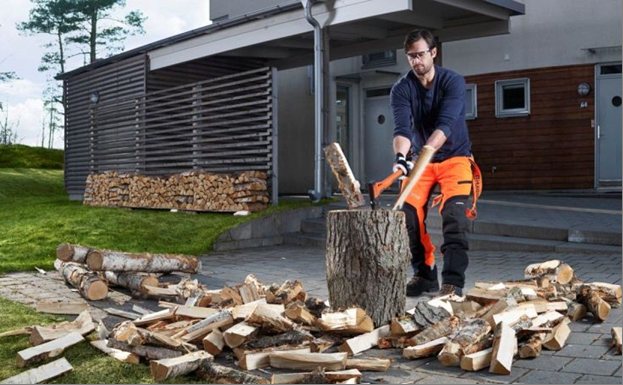

In the recommendations of an experienced summer resident how to light a fireplace, most of the time is devoted to the issue of choosing firewood for kindling. The monologue will mention the types of wood suitable for kindling. Much will be said about the storage conditions for firewood. And a separate demonstration lesson will be devoted to how to properly chop wood chips for kindling. What can be said about this, all this is correct and true. And it depends on the quality of the firewood how quickly the flame flares up, and what color the room will be filled with.
For a fireplace, especially for the kindling process, firewood is usually harvested in advance.To do this, they are brought into the room for final drying in 7-10 days. The firewood must be hardwood. Since hardwoods do not emit tar during combustion. Thus, they do not smoke as much. Coniferous wood is good for kindling. They split perfectly and from them you can get both small chips for ignition, and a small torch to start burning.
If possible, a firebox is built on the site for storing firewood. Fresh firewood is absolutely unsuitable for kindling, and in the process of stoking it is of little use. But there will be a lot of smoke and soot from them. So if it is possible to dry the wood for a year or two, then it is better to do it.
During the ignition process, it is not recommended to use handicraft ignition fluids, much less pure gasoline or diesel fuel. As a last resort, dry alcohol can be used. It is much safer than lighter fluid. It does not spread over the firebox, its flame has a local effect, the burning time is longer than the burning time of the liquid. And the most important thing is that dry alcohol does not flare up, but flares up slowly, which is required for the gradual ignition of a fire on wood.
Fuel types
Do not forget that drown
fireplace you need only the type of fuel for which it is used.
It is best to apply dry hardwood. Firewood, which contains a lot of moisture, produces a lot of ash and smoke, and helps the formation of condensation. Dry wood is mostly dark in color, produces a clear sound and has cracks at the ends. Not so long ago, firewood that has been felled is never dry. The moisture content of such wood exceeds 50%. To get dry, they need to lie down all year, either indoors or in clean air. In the first variant, the humidity is reduced to 15%, and in the other - to 25%. It is recommended to keep firewood in a woodpile. To increase the speed of drying firewood, experts recommend putting firewood in each next row perpendicular to the previous row.
You can make a specialized firebox in the fireplace body - a niche in which firewood will be stored. In this situation, the problem of the safe location of the firebox becomes the problem, in order to avoid a fire. In most cases, it is done below, under the combustion chamber, while being isolated from the part for the firebox. If you are not sure that the fire safety technique will be followed, we advise you to keep the firewood away from the fire.
Firewood should be kept split. The thickness and length of the firewood should be almost the same. A thickness of 6-10 centimeters is considered favorable. The length should be 3/4 of the width combustion chambers... The average length of the firewood should not be higher than 30-40 centimeters.
The highest heat output is found in hardwood: oak, beech, ash, birch, apple, pear, hawthorn and yew. Yew, beech, oak are hard to chop and melt. All other rocks are easy to prick, they burn beautifully. It should be said that slow combustion is inherent in hardwood.
Medium hard wood is determined by the average calorific value. These are fir, cedar, elm, cherry. At the same time, firewood from fir, elm and cherry, when burned, smokes very strongly.
Soft coniferous wood contains a lot of resin, it gives off a little heat, while leaving a lot of soot that settles on the inner walls of the fireplace. This wood splits easily, burns well, but very often sparks. Soft species include spruce and pine. The significant advantages of conifers include a good smell of burning firewood.
The most popular are birch firewood, which is easy to split, burns well and contains little resin. Plus, such firewood is the most affordable in the center of Russia.
Dry branches of cherries, junipers, pears, apple trees are often used for the fireplace because of the pleasant aroma that is formed during a fire.
Spray and rag
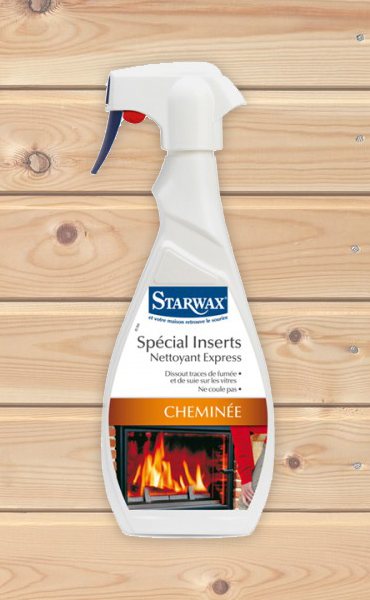

Another necessary tool is a glass cleaner.No matter how cool the fireplace is, no matter how well the glass burns out, anyway, sooner or later it becomes necessary to clean them.
There are a lot of cleaning sprays. The manufacturer is not that important.
Together with the cleaner, it is advisable to use a disposable synthetic cloth. It is sold in hardware stores and markets. Without it, cleaning the glass correctly is also quite difficult.
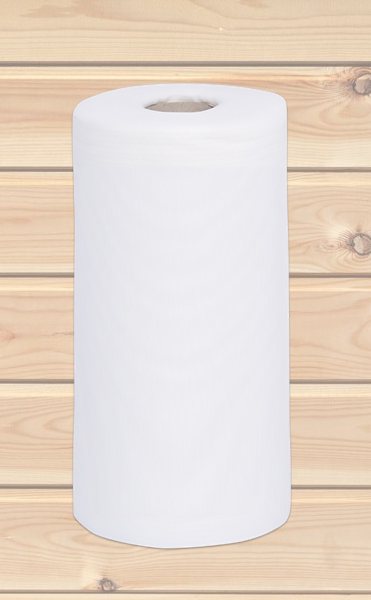

Fire burner
Again, as I used it, I came to the conclusion that lighting a fire with just matches is not very convenient. Therefore, I purchased another device - a portable gas burner. Which is used in car repairs. She can often be found in an auto parts store. With the help of such a compressed gas cylinder, it is very easy and convenient to kindle a fire in any weather.
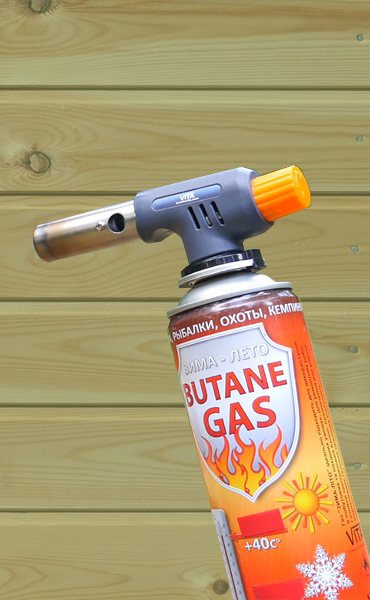

Gloves
Few people think that gloves are needed. Special fire-resistant, made from very thick suede. It is a must for almost any stove and fireplace to supply firewood. Do not throw them there, but put them neatly.
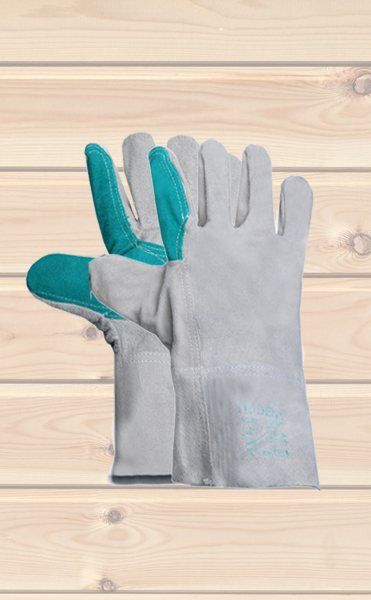

A good manufacturer puts gloves on heating equipment. For example, every Contura oven has heat resistant gloves. But they can be easily bought in the markets.
How to heat a gas fireplace
Russian fireplaces that run on gas are shown by the following models: fireplace
"Amra" with infrared burner GIIV-1;
fireplace "Ray" - with a GII-3 burner.
It should be said about infrared burners. This kind of emitter is present in many Russian gas models of recent times. The emitter consists of a burner, a heat-resistant grate, which is located on top of a gas-fired burner. During the process combustion chambers
liquefied gas or network gas burns with a small blue flame, and the heat-resistant grate is heated to 800-900o. An infrared burner is effective for heating large areas. The most productive use of such fireplaces in areas with a climate of temperate latitudes. However, as additional heating, fireplaces with similar burners can be used in regions where the temperature is lower - 30o in winter.
Cart is empty
From January 1, 2020, due to the increase in the VAT rate to 20%, the price of the overwhelming majority of goods will increase. Hurry up to buy a stove, fireplace, chimney or barbecue before the price increases!
Russian has started serial production of shell and marble fireplaces. Now you can purchase a Russian-made combustion chamber in a set with finishing.
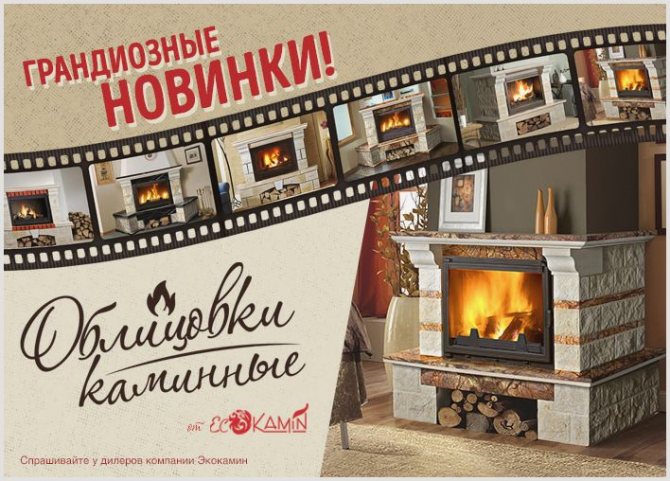

Friends, in the warehouse, the wide fireplace combustion chamber MCZ Forma 115 misses its own future owner. This combustion chamber was purchased at the old rate and we have the opportunity to present a 20% discount on it.
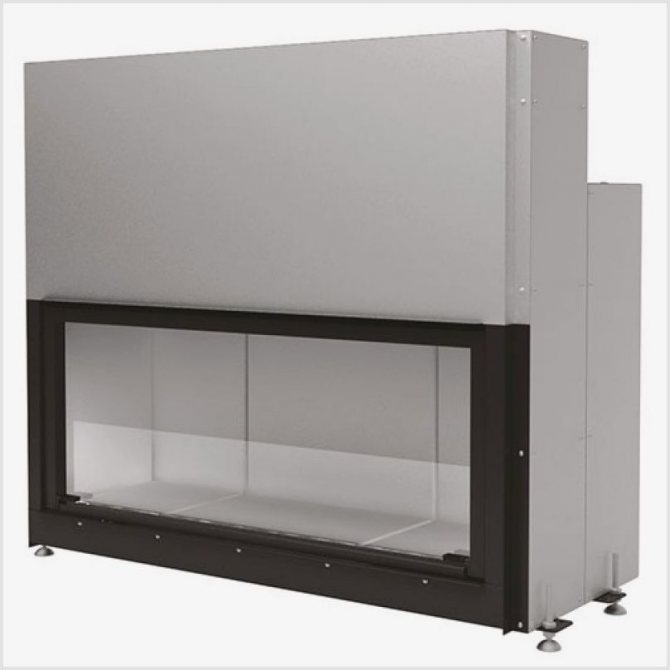

Electric fireplaces
An electric fireplace can effectively and quickly heat a room up to 20-25 m2. But the main purpose of installing these fireplaces is to decor and create thermal comfort in a house equipped with a heating system of any kind. Electric fireplaces have a huge number of modifications, models are varied in size and style.
Almost all electric fireplaces imitate portals of wood-burning fireplaces, and the design can be anything - the firebox is made in classic cast iron and steel, or for a high-tech interior - metal and glass.
The electric fireplace today has a liquid crystal display and a sound stereo system, which provides visualization of genuine fireplace classics - burning firewood, sparks, crackling, etc. Prices for modern electric fireplaces are quite high, and the consumption of electricity is rather big. But the operation of such a fireplace is no more difficult than any electrical appliance, and soot and ash do not need to be cleaned.
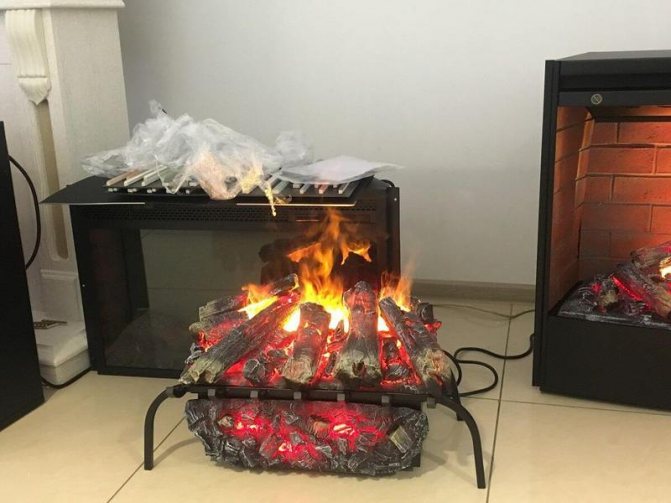

WHAT IS BETTER FIREWOOD FOR A CAST IRON OVEN? WHAT TO STUFF THE FIREPLACE WITH?
A fireplace or stove is not only attractive decorative details that are widely used in modern interiors, but, first of all, a good heat source released when burning wood.Fuel selection for combustion chambers fireplace or wood-burning stove, affects not only the operating efficiency of the radiator, but also its appearance, service life and heat output. Due to this, questions about the choice of fuel for a stove or fireplace must be taken seriously. We will try to tell you in detail what types of fuel can be used to heat a stove or fireplace, and which is better to refuse to use.
WHAT IS POSSIBLE TO STUDY A FIREPLACE, OVEN?
Of course, a real classicism style fireplace has no association with anything other than wood. But, today's living conditions make their own adjustments and in addition to the aesthetic beauty of a living flame, the buyer also asks that when the fuel burns, a large amount of heat is emitted, and the period of operation of the stove from one load of firewood should be as long as possible. All this became the reason that for fireplaces and long-burning stoves, production workers began to release long-burning firewood - pressed fuel, in structure resembling fuel pellets, but having a larger size. This begs the question: “Is it possible drown wood-burning stove with briquettes? " Pressed logs, euro wood, briquettes - all this is the name of one type of fuel made from shredded wood of various species, coal, peat and characterized by good heat return and a long burning period. However, the stove or fireplace with Euro wood has a couple of properties. Let's consider them in more detail: wood briquettes flare up perfectly and maintain continuous combustion for 8 hours with full laying of the hearth. The briquettes will need to be lit in batches; first, you need to light the minimum amount of firewood in order to give the pressed logs a good fire, and then add a new batch of briquettes. The burning time of euro wood from peat can be up to 6 hours. When burning any kind of briquettes, it will be briquettes in the form of fuel or wood briquettes, it is released almost 30-50% more than with a combustion chamber with ordinary wood, while the burning time of Euro wood is longer, almost half. What results in such a long burning time? When comparing briquettes for burning and firewood, it is necessary to understand the principle of the pressed fuel production process. During processing, moisture is completely removed from the crushed initial raw material (specific humidity will not be more than 11%). Then, very small particles are pressed so that there are no empty spaces between them, which ensures a high density of briquettes and guarantees the same combustion without sparks, with very little smoke emission, which plays an important role for open fireplaces. During the manufacturing process, resinous inserts are also removed, thanks to this, pei and fireplaces are allowed drown briquettes even from coniferous trees. However, it should be borne in mind that the heat output of compressed softwood fuel is less than that of hardwood substitutes. All the same, choosing what drown fireplace, with real wood or briquettes, take into account that the pronounced aroma of burning wood and a pacifying crackle can only be when burning chopped wood.
WHAT FIREWOOD to use for the FIREPLACE?
Very good firewood, with a high efficiency and the highest heat capacity, is harvested from hardwood. Ideal for the camera combustion fireplace
Iil stove beech and oak, you can use acacia, aspen or any fruit tree. Beech and oak are deservedly considered "elite firewood". These rocks burn evenly and brightly, pleasing to the eye. During burning, there is a pleasant and even crackle. Beech firewood, in terms of its own heat output, is almost unmatched. Such characteristics are also distinguished by oak firewood. Oak firewood burns for a long time, almost does not emit smoke and does not spark.One drawback of these wood species for kindling a fireplace or stove is their high price.
The advantage of fruit tree species is the exclusive smell that enters the space of the room upon fire. It is customary to heat rooms for living with firewood from fruit trees, such as a apple-tree, a pear, a plum. For some time, with regular use of "fruit wood" in the room, a stable smell of wood appears.
Alder and aspen firewood have a really extraordinary specificity. When they burn, neither smoke nor soot appears. In addition, the fire that forms when burning alder burns out the soot in the middle of the chimney, which helps to clean the surface inside the chimney and further settle the soot. With regular use of a stove or fireplace, it is recommended to heat them with alder or aspen at least once every couple of weeks to eliminate pollution of the chimney. Don't forget, most fires are actually caused by the excessive formation of soot in the middle of the chimney!
Regardless of the variety of woods, hardwoods are the most common and popular fuel. The most convenient way to heat a stove or fireplace is hazel, acacia, cherry, birch, maple. Due to the simple and cheap procurement of raw materials, the relatively inexpensive cost of the wood itself, these types of wood are considered the most optimal for combustion chambers stoves, wood-burning fireplaces and boilers. All these firewoods are perfectly pricked. Acacia is characterized by the strongest heat emanating from the coals. Birch firewood burns perfectly even when damp, however, it is required to look after the constant flow of clean air and traction parameters, since the minus of oxygen when firewood from birch fires leads to the appearance of birch tar in considerable quantities, which helps the rapid contamination of the combustion chamber and the surface from glass.
Less suitable for combustion chambers
firewood is poplar and linden. Firewood has a lower density, burns quickly, while the heat release is minimal.
Regardless of the woody varieties, the necessary requirements are imposed on all firewood: they must be dry and not rotten.
WHAT CANNOT BE FURNISHED BY THE FIREPLACE?
For the lifetime of the fireplace, its durability and the appearance of the fireplace combustion chambers
with glass, the selected type of firewood has a significant effect. Apart from the recommended types of wood described above, there are types of fuels that are highly discouraged to burn in a fireplace or wood-burning stoves - these are coniferous wood. Coniferous wood is not dense, in the middle of it there are voids filled with resinous deposits. When the next pocket of resinous substance ignites, it occurs, in other words, a "microexplosion". Actually, therefore, when firewood from spruce or pine fires, sparks and coals jump out of the fireplace. Plus, from the pier it burns with the release of a considerable amount of soot, which settles on the walls of the combustion chamber and contaminates the sight glass.
Stoke the fireplace
pine spruce firewood is not worth it, for another reason. When burning spruce or pine, in the flue gases, apart from tar, there is a significant amount of soot with an oily structure. Soot settles on the surface inside the chimney, which leads to a gradual build-up of a dense layer on the inner void of the chimney pipe. Under the influence of temperature, the resinous layer is compacted and hardened, which makes it almost impossible to remove. In a similar way, the initial section of the chimney narrows, which will then be poorly displayed on the draft. However, the main danger is that spontaneous combustion of soot in the middle of the chimney is quite common, which can cause not only the pipe to become unusable, but also cause a fire. Not recommended
drown fireplace and stove raw with wood.Wet wood is a source of soot, smoke and soot that settles on the walls of the chimney. All this reduces the service life of the hearth itself and the smoke removal system in general.
Fireplace operation - the most common mistakes
Proper use of a wood burning fireplace
1. For the fireplace to be well heated, it must be clean. The topnu needs to be cleaned every season and the chimney every three months. Before the start of the heating season, remove soot and ash through openings closed with bricks or doors. Having worked with a poker, after cleaning, close the door tightly, and insert the brick into place, fixing it with a solution (first moisten the brick and masonry with water). Remove ash and debris from the firebox (make sure the fireplace is completely cool before cleaning), and sweep or vacuum the small particles. Make sure the damper is wide open before using the fireplace again.
2. The wisest decision is to entrust the crank of the chimney to a professional. The specialist will inspect the deflector that protects the chimney from dust, debris, precipitation and small birds, clean the pipe, check the seams and joints, eliminate defects and confirm the safety of the fireplace.
H. If the fireplace smokes, place a hood on the chimney. To cut off other causes of smoke (improper masonry or structural defects), such a test will help: put two halves of bricks in the corners of the pipe and cover them tightly with a sheet of metal. If the case is in the cap, the fireplace will stop smoking.
4. The fireplace can smoke when kindling, if it has not been heated for a long time and has become damp, as well as due to back draft in the chimney, when it is cooler in the house than outside. In such cases, it is necessary to open the forward stroke valve (if any) or warm up the pipe by burning paper at its base (in cleaning) and at the same time lighting a fire in the firebox. You can also warm up the cold chimney with a torch or a fireplace lighter directed into the chimney before lighting the fire. Do not forget to close the latch after lighting it up.
5. The fireplace copes with heating worse due to poor fuel quality, soot deposits or a loose damper. Check the condition of the firebox every month and periodically heat the fireplace with aspen or alder wood: they contribute to burning off the soot. The danger of soot is that creosote accumulates along with it when the fuel is incompletely burned, and this is a flammable substance that can lead to a fire.
6. If soot accumulates on the ceramic glass door, a short-term intensive combustion is sufficient: the high temperature will burn the soot particles. Otherwise, soak a crumpled piece of paper, dip it in the ashes at the bottom of the fireplace, and wipe the glass with this ash-coated paper. Then wipe the glass with clean paper - not a trace of soot will remain.
7. But it is not worth getting rid of ash too often. Ash at the bottom of the hearth insulates the surface from the heat. In addition, chunks of unburned charcoal will help start the fire faster. Coals can smolder for a very long time, so collect ash in a metal bucket with a lid and do not throw it into a trash can when smoldering. Ashes from untreated wood (without nrasons and packs) can be used as fertilizer, but cannot be composted.
8.To clean namin of soot less often, heat it properly. If you use wood to fire your fireplace, make sure it is dry. Hardwood dries more slowly than softwood. The ideal solution is to use logs that have been separated into different types and kept separately for at least six months. If you store firewood outside, make sure that it does not come into contact with the ground (the distance should be at least 30 cm), and there is ventilation between the logs. To protect the woodpile from dew and rain, cover it with a tarp.
9. By burning paper and wood together, a small fire can be achieved, which gives a lot of heat. As soon as the fire intensifies, add large logs to the kindling. To keep the fireplace cool, toss hardwood firewood into the flames.There will be almost no dirty smoke from a small hot fire.
10. Use only natural wood and white matte paper for kindling the fireplace. Other combustible materials can damage the chimney and your health. If heating with briquettes, choose those that have the least amount of pollutants. It is better to abandon coniferous wood: resins will cause creosote to accumulate in the chimney, which can lead to a fire. It is safer to heat the fireplace with wood and hardwood briquettes (maple, birch, oak) - they are the most environmentally friendly and give a long hot fire.
11. Heat for 1.5-2 hours (depending on fuel) in the morning and evening, without overheating the fireplace. The more the stove is heated, the more heat will simply fly out. The walls of the fireplace should not be heated above * 80 ″ C.
12.In the optimal mode of combustion, the wood crackles fervently, and the fireplace hums slightly. At the same time, the flame is light yellow, and the smoke from the chimney is colorless. The quality of burning depends on the correct laying of firewood. The height of the bookmark should be up to 30 cm.
13. Do not try to increase the power of the fireplace by replacing the wood with charcoal or other high-calorie fuel. And do not open the damper fully to speed up heating; the thrust will increase, but the heat loss will also be higher. When the fire is stable, close the damper.
14. For regular maintenance of the namin, get all the necessary tools - a scoop, a brush, tongs, a poker. For fireplaces with an open hearth, purchase a protective screen that will protect your home from firing sparks.
15. Never flood the flame with water: the fireplace will crack due to temperature fluctuations.
Reference by topic: Installing a fireplace with an open and open firebox - photos, drawings, prices, instructions

